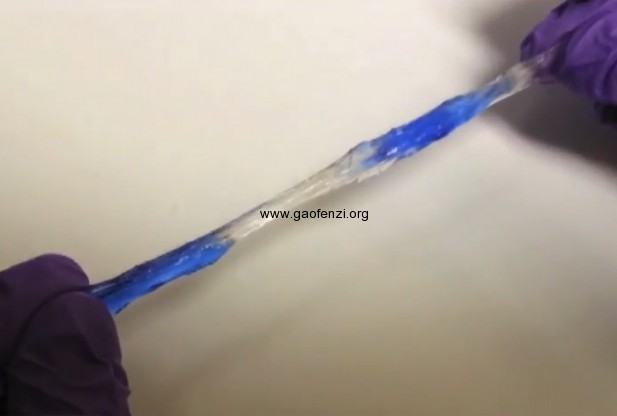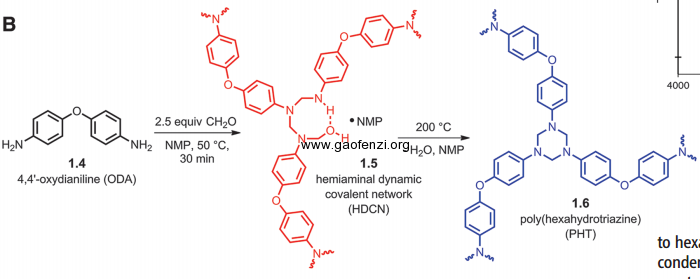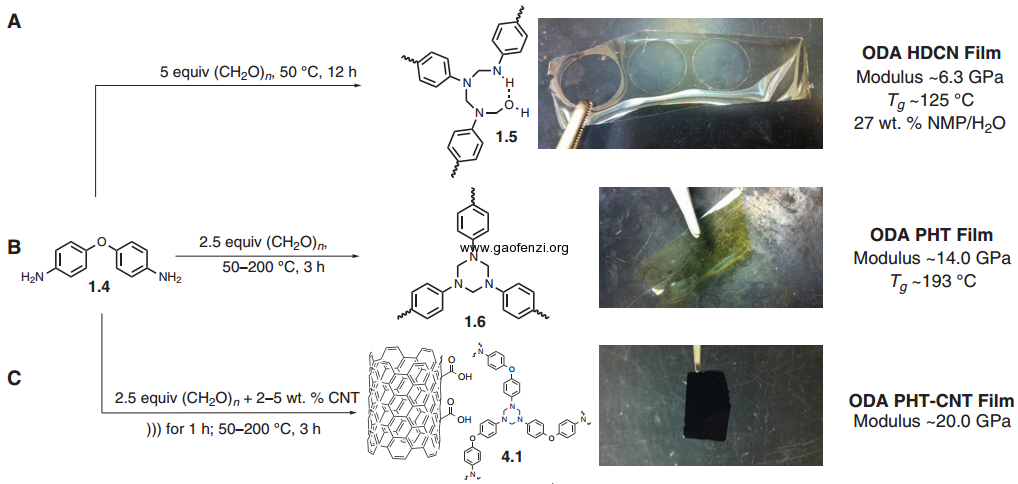IBM实验室一个小小失误以致发现一种可自修复、可回收和超强的工业级热固性聚合物材料,可应用于汽车、飞机和电子材料,而且对环境友好,成本低廉。这项发现和研究成果发表在最近的science杂质上。
所谓的小失误:研究人员Jeanette Garcia博士在一次研究项目中少使用一个组件,结果(偶然)发现了这种热固性材料,材料的成分简单,而且坚硬和稳定,令其感到震惊的是这种类型的材料从未被报道过。

研究人员将paraformaldehyde(低聚甲醛) 和 Diamines(二胺)混合通过控制不同的缩聚反应温度得到不同性质的材料(是不是很有意思,原料相同,处理温度不同,获得的材料化学结构不同,获得两种不同性质的材料)。反应原理如下:

以paraformaldehyde(低聚甲醛) 和4,4ʹ-oxydianiline(4,4ʹ-二氨基苯醚)反应为例子,当在较低温度下(50摄氏度)缩聚得到一种有机凝胶材料,简称为HDCN,氢键作用吸收一定含量的水分,材料具有高强度、稳定性和自修复功能,这种性能可应用于胶黏剂、或者用于染料和药物的传输。而且可以回收,当这种材料遇到酸性水溶液时,聚合物材料可溶解回收,意味这这种材料可应用与半导体制造工业,即借助酸性水刻蚀这种材料(现在的半导体是采用光刻蚀的方法制备,具体可以参加百度百科)。
更为精彩的是,上述在较低温度下制备的HDCN材料,在200摄氏度温度下处理,会得到另外一种新材料,简称为PHT。简单的过程是,HDCN有机水凝胶再200摄氏度作用下失水,化学结构发生变化,形成新的N杂环,形成化学结构与HDCN不同材料PHT。据悉,PHT材料强度高于骨头,刚性强。除此之外,材料具有轻质、耐溶剂(强于PSU)、可回收,但是易碎,像玻璃。PHT材料与碳纤维材料可复合性质轻质的材料,强度超强类似金属,当被外力破碎后,具有一定程度的自修复功能。

参考文献如下:
Science 16 May 2014:
Vol. 344 no. 6185 pp. 732-735
DOI: 10.1126/science.1251484
标题:
Recyclable, Strong Thermosets and Organogels via Paraformaldehyde Condensation with Diamines
作者:
Jeannette M. García1,*, Gavin O. Jones1, Kumar Virwani1, Bryan D. McCloskey1,2, Dylan J. Boday3, Gijs M. ter Huurne4, Hans W. Horn1, Daniel J. Coady1, Abdulmalik M. Bintaleb5, Abdullah M. S. Alabdulrahman5, Fares Alsewailem5, Hamid A. A. Almegren5, James L. Hedrick1,*
摘要:
Nitrogen-based thermoset polymers have many industrial applications (for example, in composites), but are difficult to recycle or rework. We report a simple one-pot, low-temperature polycondensation between paraformaldehyde and 4,4ʹ-oxydianiline (ODA) that forms hemiaminal dynamic covalent networks (HDCNs), which can further cyclize at high temperatures, producing poly(hexahydrotriazine)s (PHTs). Both materials are strong thermosetting polymers, and the PHTs exhibited very high Young’s moduli (up to ~14.0 gigapascals and up to 20 gigapascals when reinforced with surface-treated carbon nanotubes), excellent solvent resistance, and resistance to environmental stress cracking. However, both HDCNs and PHTs could be digested at low pH (<2) to recover the bisaniline monomers. By simply using different diamine monomers, the HDCN- and PHT-forming reactions afford extremely versatile materials platforms. For example, when poly(ethylene glycol) (PEG) diamine monomers were used to form HDCNs, elastic organogels formed that exhibited self-healing properties.
注:中文介绍翻译不好,建议大家阅读上述参考Paper了解这种类型的材料。